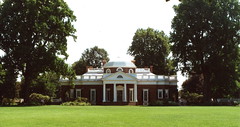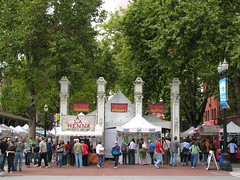Traveling and Shopping in Scottsdale
Tuesday, December 15th, 2009So, you’ve arrived in Scottsdale and you’ve got your plastic ready.
Let’s go shopping! (more…)
So, you’ve arrived in Scottsdale and you’ve got your plastic ready.
Let’s go shopping! (more…)
When I first traveled to Arizona, everyone talked about Scottsdale as some magical place. This week we’ll be featuring Scottsdale. You can decide whether it is magical for yourself! (more…)
Since we feature favorites on Fridays, we’re returning to a favorite activity that is quite terrific in the Phoenix area: powered paragliding (PPG). (And also available elsewhere, but the weather is very favorable for this in Arizona.)
Getting up in the air is a great way to put life in perspective, clear your head and find an exhilaration that is hard to match. (more…)
Less than 20 minutes from Phoenix Sky Harbor Airport heading east are three attractions well worth seeing when you’re visiting in the Phoenix area. Bring your camera, because you will want to record your views – they are unique! All are around the area called Papago Park. (more…)
The first time I came to Arizona, it was a major revelation for me. The sunny, blue skies were so welcoming – even at the 100-plus degree temperatures in the middle of summer. I got off the plane and, when it was time to go back, I really didn’t want to!
If you are taking any airline except for Allegiant (see our blogs on our trip to Oregon), you’ll likely land at Phoenix at Sky Harbor Airport. Terminals are large and do include amenities like moving sidewalks for some of the long walks from your arrival gate down to baggage claims. (more…)
Welcome to the land of the sun!
Phoenix, the fifth largest city in the USA, is the most glorious destination (more…)
Okay, you’ve got some money, you’ve got some land up on a hill, and you’ve got some brains. But, what you don’t have is a place to live! What will you do? What will you do?
Thomas Jefferson, never at loss to come up with a new idea, decided he was going to build a house on the hill as the centerpiece to his 5,000-acre plantation.
And talk about privacy! You can’t see it from the road, even if you know where to look.
Preparation of the site began in 1768 with construction beginning the following year. With approximately 11,000 sq. ft. of living space, this is not your basic suburban master-planned community house. Monticello was designed by Jefferson after a visit to Europe. The Roman neoclassic design contains forty-three rooms following a remodeling expansion completed in 1809.
Much of the construction material came from the land around the house. The window glass came from Europe and about one-third of the glass now in the house is original.

Monticello - Thomas Jefferson's home
Of interest is Jefferson’s bed, which he designed after seeing alcove beds during his time in France. Taking the idea of beds built into walls upon his return from Europe, Jefferson redesigned Monticello, adding an alcove bed to his bedroom, but leaving both sides open. This connected his bedroom with his study. So, Jefferson was never totally hidden away in his bedroom, but was able to access both rooms easily. Obviously, Jefferson was not a man to rest easily.
Tours of the house run constantly throughout the day with timed tickets, so it is best to visit other areas of Monticello following your background tour.
Those background tour areas include the Gardens, dependencies, Mulberry Row and Jefferson’s gravesite.
Tickets are available throughout the day on a first come-first served basis. Tours of the house begin every 10 minutes.
House Tour/Grounds: Nov. – Feb. $15.00 / March – October $20.00
Age 6-11: $8.00
Hours Vary – See Website for calendar of hours.
Tomorrow – Come back for a retrospect on our blog and some things to be thankful for.
There’s something about a college town. I’m not talking about New York City, Boston, or Los Angeles, but rather those small to mid-sized towns that cater to, or are intricately involved with, the day–to-day operations of the campus.
Virginia has several such towns, Lexington (Washington & Lee University), Williamsburg (College of William & Mary), Blacksburg (Virginia Poly Tech), Radford (Radford University), even Farmville (Longwood University) are a few of the ten such towns that are labeled “college towns.”
But, my pick for this article is Charlottesville.
Home to the University of Virginia, designed by United States President and signer of the Declaration of Independence, Thomas Jefferson, Charlottesville is just over an hour from Richmond, and easily accessible by car or plane. Current population of just under 50,000 makes this a small college town with amenities that you might not find in other towns of this size. (more…)
It’s the Capitol of Virginia, but it has also been the Capitol of the Confederacy, a claim no other U.S Capitol can come close to. Although the Civil War has been over for 144 years, the past lives on alongside the present.
As a former resident of the city for several years, it’s always interesting to come back and re-visit just why you lived somewhere, and maybe even why you left. In the case of Richmond, I relocated there for a job and left for the same reason.
Richmond is a mix of a modern and also a “stuck in the past” city. The latter would be their Civil War heritage.
But, that shouldn’t stop anyone from visiting as there are many things to see and do and you don’t have to see a single battlefield, Civil War or Revolutionary War, if you don’t want to, and still have a great time.
Are you into literature? Edgar Allen Poe lived in Richmond for over 13 years. The Poe Museum is located on Broad Street (Poe didn’t actually live in the house, but nearby). Furniture from his home, as well as manuscripts, first editions and personal belongings, are on display.
Architecture? How about a 15th century English estate (Agecroft Hall) that was bought at auction, crated and shipped from Lancashire, England to Richmond, and reassembled on the banks of the James River.
Famous speeches? Revolutionary leader Patrick Henry wasn’t shy about speaking. He gave his famous “stick it to King George” speech, “Give Me Liberty, or Give Me Death” at St. John’s Church in Richmond.
www.historicstjohnschurch.org/hist_main.htm
Monuments? How about … Monument Avenue? Northwest of downtown Richmond you’ll find Robert E. Lee on a horse … J.E.B. Stuart, on a horse … Stonewall Jackson, on a horse … Jefferson Davis (President of the Confederate States of America), not on a horse.
Anyone notice a theme … and we’re not talking about the horses.
And then, there is Matthew Fontaine Maury. Who? Seriously, WHO?
And finally, a slightly controversial choice for an avenue with statues of Confederate soldiers — we have
Arthur Ashe, professional tennis player, born and raised in Richmond.
Even if you don’t like statues, the architecture along the avenue ranges from English Tudor, Georgian, Italian, and Art Deco on either side of center islands of huge trees and green grass. It’s the kind of street they don’t build anymore.
Historic Theatres with a Pipe Organ? The Byrd Theatre in Carytown, a retail shopping area northwest of downtown was opened in 1928. Included in its 1,300 seat configuration is a balcony and a Wurlitzer Pipe Organ that opens the show on Saturday evenings by rising from the basement to the stage in front of the screen.
You can’t buy tickets ahead of time, they don’t show previews, and the movies aren’t first run … but at $1.99, I’m not going to complain!
http://www.visitrichmondva.com/
NEXT TIME: We’ll take a trip back in time and look at the Civil War history of Richmond and what remains today.
Portland’s Saturday Market is misnamed – it is also open on Sunday. Unlike most craft fairs that come and go, the Portland Saturday Market is open from the end of February through December 24.

Portland Saturday Market - or part of it
And, this is one of those places that is a must-see if you’re coming to Portland. The array of hand-crafted items to see and purchase is dizzying. Creativity abounds! (more…)